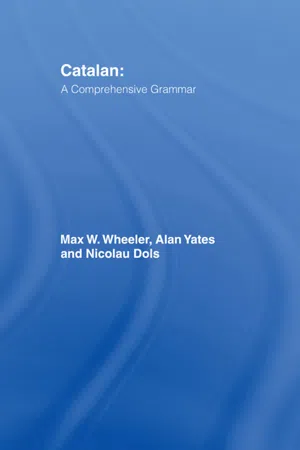![]() PART I NOUN PHRASE CONSTITUENTS
PART I NOUN PHRASE CONSTITUENTS![]()
1 GENDER OF NOUNS
Catalan displays the phenomenon of grammatical gender agreement found in many European languages (and elsewhere). Every noun is either of masculine or of feminine gender; adjectives which modify the noun, as well as pronouns which cross-refer to it, are required to take the same, ‘agreeing’, gender. For example:
Aquell armari vell era ple, i el vam haver de buidar
that (m.) cupboard (m.) old (m.) was full (m.), and it (m.) we-had to empty.
That old cupboard was full, and we had to empty it.
Aquella caixa vella era plena, i la vam haver de buidar.
that (f.) box (f.) old (f.) was full (f.), and it (f.) we-had to empty
That old box was full, and we had to empty it.
As is the case in most languages, the masculine gender is semantically ‘unmarked’, in that it is also used when referring to groups of mixed biological gender or to persons of unknown or unspecified gender:
| els italians (m.) | Italian males or Italians in general |
| els professors (m.) | male teachers or teachers of either sex |
| els pares (m.) | fathers or parents |
| elsfills (m.) | sons or sons and daughters (male and female) or children (sex unspecified or unknown) |
| Si algú arriba d’hora, feu-lo (m.) esperar. | If anyone arrives early, have them wait. |
| but les professores (f.) | female teachers |
In addition to masculine and feminine gender, Catalan is unusual among Romance languages in having a special neuter agreement pronoun ho, used when no noun has been mentioned or is in mind. Its use is explained in section 12.5.
1.1 GENDER OF NOUNS REFERRING TO HUMANS AND FAMILIAR ANIMALS
As a very general rule nouns referring to female humans and female familiar/domestic animals are of feminine gender (e.g. tia ‘aunt’, xinesa ‘Chinese girl/woman’, gallina ‘hen’), and those referring to male humans and male familiar/domestic animals are of masculine gender (e.g. oncle ‘uncle’, xilè ‘Chilean boy/man’, gall ‘cock’) which is, of course, the source of the names masculine and feminine for the two agreement classes. There are a few exceptions, to be mentioned below (1.1.6).
Generally we find pairs of nouns, one of masculine and one of feminine gender, for the corresponding male and female referents; these pairs are morphologically related in a number of possible ways. In the majority of cases, human males and females and males and females of familiar/domestic animals are denoted by distinct word forms. In the case of words denoting professions that were traditionally exercised only by men, the morphologically related feminine form is used to denote ‘wife of …’ such as alcaldessa ‘mayoress’; currently such forms are used mostly of women who exercise the profession in their own right. With professions that are even now exclusively male (e.g. military) the former convention may survive.
1.1.1 DERIVATION OF FEMININES WITH -a
The commonest pattern is that in which a feminine noun is derived from the corresponding masculine one by the addition of the feminine gender suffix -a (replacing any unstressed final -e or -o of the masculine). Thus:
| fotògraf (m.) | fotògrafa (f.) | photographer |
| noi (m.) | noia (f.) | boy/girl |
| company (m.) | Companya (f.) | companion |
| fill (m.) | filla (f.) | son/daughter |
| pediatre (m.) | pediatra (f.) | paediatrician |
| monjo (m.). | monja (f.) | monk/nun |
| etc. |
In many cases there are consequential modifications to the spelling or pronunciation (or both).
(i) A different written accent may be required (according to the general accentuation rules – see 37.5; these modifications apply to all parallel cases):
| avi (m.) | àvia (f.) | grandfather/grandmother |
| pagès (m.) | pagesa (f.) | farmer |
| Lluís (m.). | Lluïsa (f.) | (Louis, Louisa – given name) |
| etc. |
(ii) Those ending in a stressed vowel add -na in the feminine:
| germà (m.) | germana (f.) | Brother/sister |
| beduí (m.) | beduïna (f.) | Bedouin |
| etc. |
Also, irregularly, rei (m.) ‘king’ → reina (f.) ‘queen’, orfe (m.) → òrfena (f.) ‘orphan’.
(iii) Those ending in -òleg have -òloga in the feminine:
| cardiòleg (m.) | cardiòloga (f.) | cardiologist |
| sociòleg (m.). | sociòloga (f.) | sociologist |
| etc. |
(iv) A few of the nouns ending in -s double the s in the feminine:
| gos (m.) | gossa (f.) | dog/bitch |
| ós (m.... |
